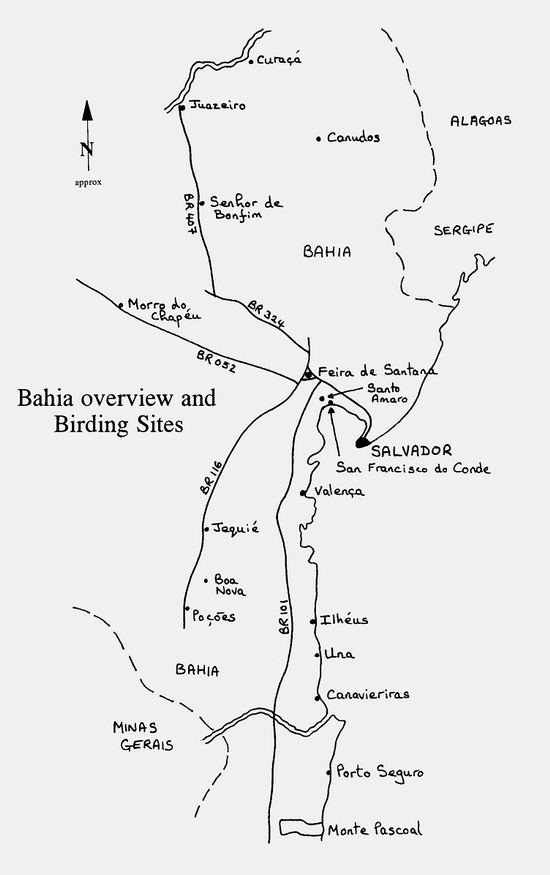Section 1 - Introduction, logistics, itinerary and general information.
Section 2 - Birding sites (part 1).
Section 3 - Birding sites (part 2).
Section 4 - Birding sites (part 3).
Section 5 - Annotated checklist.
Birding Sites
|
Included below are details of access, accommodation, habitat and species for all sites visited. Although most of these sites are known birding localities they are, at best, infrequently visited. Additionally, other areas not previously birded, were visited either on-spec, or at the suggestion of others. Sites are presented roughly in the order in which we birded them; from Salvador, northwestward into the interior, and then southward down the coast. Though some sites lack data, as far as possible each site is accompanied with a species list (in the worst case merely our own sightings). Those species observed by us are marked with the number of individuals seen or heard. Those not marked have been reported by other observers. A 'c' denotes that the bird was common or fairly so. Bold typeface identifies species of particular note; rare, endemic, or which might be considered a target at that locality. |
Santo Amaro
A few forest remnants west of Santo Amaro are now almost the only place where the highly endangered Fringe-backed Fire-eye is known to occur. Even historically this species had been known only from a limited area, but extensive forest clearance, still continuing, has resulted in the current precarious situation. The best place to look for this species is along a forested escarpment south of the BA026 highway running westward from Santo Amaro toward Muritiba. Santo Amaro sits on the northern edge of the Baía de Todos os Santos, and is within an hour's drive from Salvador. The BA026 highway starts from opposite the Esso petrol station in Santo Amaro, where you should zero the trip-meter. After a few kilometres the road passes a decrepit, smelly factory on the right (paper mill? sugar cane processing?), and at 7.6 kilometres a rough driveable track leads off left, a few hundred meters, to a large bulldozed area which is currently being used as a dump for caustic soda. Although we would consider it unlikely that anyone would wish to break into the car here, one worker at the site did advise us to park the car out of sight of the road. The dump is directly at the base of the escarpment which runs a few kilometres east and west.
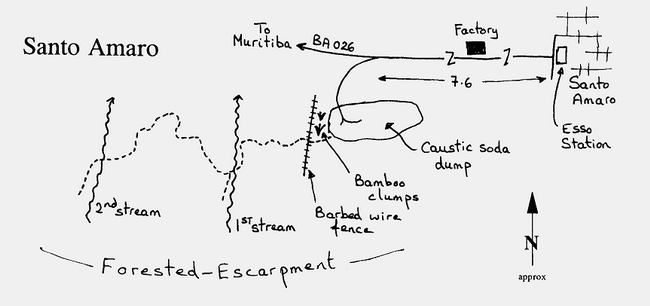
As the forest is principally secondary growth, access is difficult. However, a footpath can be found at the rear, western corner of the dump. Follow this path for about 300 metres, climbing under a barbed-wire fence, to arrive at the first stream, which is covered in heavy tangles, and where the path first enters the forest. Once inside the forest the path almost immediately crosses the stream, after which it begins to become less well defined. We followed what appeared to be the main path, which ran more or less along the base of the escarpment, rather than ascending it. After approximately a further 600 metres we arrived at a second stream at which point the trail largely disappeared, so we hacked up the fairly open, steep sides of the stream gully. The Fringe-backed Fire-eye has been seen in dense foliage here (Forrester 1994), though we failed to locate it.
During our second attempt to find this bird we ascended the western side of the steep gully of the first stream, where we saw a male in dense vegetation, about 80-100 meters from the point of crossing the stream. Like most fire-eyes, this species was responsive to tape - even that of the closely related White-shouldered Fire-eye which its call strongly resembles. The bird can also be found attending ants, though given the poor state of the forest here, large ant-swarms probably do not exist. [Others report that the bird could not be found here in February 1996, despite a day's effort; the bird failing to respond to tape. For other sites at which this bird has been recently relocated see Pachero and Whitney (1995)]. As no accommodation can be found in Santo Amaro, it is best to stay at the Pousada Recanto do Parque in São Francisco de Conde (see São Francisco de Conde write-up), from which it is a 45 minute drive.
Species recorded from Santo Amaro; (based primarily on our own sightings)
Spotted Nothura |
Striped Manakin Blue-backed Manakin White-bearded Manakin Elaenia sp. 4+ Yellow Tyrannulet Eared Pygmy-Tyrant 1 Myiarchus sp. 2+ Brown-crested Flycatcher 2 Sepia-capped Flycatcher Tropical Kingbird c Variegated Flycatcher Great Kiskadee c Rufous-browed Peppershrike 1 Red-eyed Vireo 2 Rufous-bellied Thrush 4 Pale-breasted Thrush 10 Moustached Wren 4+ Long-billed Gnatwren Grey-breasted Martin 2 Southern Rough-winged Swallow c Bananaquit 4+ Orange-headed Tanager 1 Flame-crested Tanager 2 Brazilian Tanager 1 Palm Tanager Sayaca Tanager c Silvery-breasted Tanager 2 Yellow-bellied Seedeater 2 Buff-throated Saltator c Pectoral Sparrow Troupial |
São Francisco de Conde
São Francisco de Conde lies within an oil-producing zone, on the northern edge of the Baía de Todos os Santos, an hour's drive from Salvador. Being close to Salvador this, and Santo Amaro, will probably be one of the first sites visited. The main attraction is the accessible mangrove, that lies in and around the mouth of the Rio Traripe, and which provide an excellent chance of finding Little Wood-Rail at low tide.
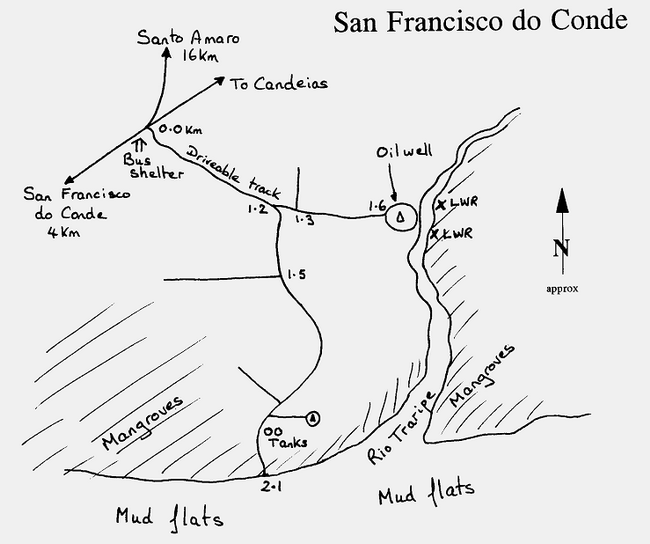
Leave Salvador on the BR110 and follow the signs to Candeias, Santo Amaro, and then São Francisco de Conde. Three to four kilometres east of São Francisco de Conde, at the fork intersection of the Candeias to Santo Amaro BA522 and the local São Francisco de Conde road, a rough dirt track leads down to the bay. This intersection is also marked by a bus shelter. Zero the trip-meter at the intersection and follow the track 1.2 km to the first fork where you should keep left. Continue straight as far as 1.6 kilometres (ignore the turn on the left at 1.3 kilometres), to a cleared area with a small oil well adjacent to the river. Little Wood-Rail can be seen here, feeding under the mangroves along the river edge at low tide, apparently at any time of day. Beware of minute biting flies that infest the mangroves - long trousers recommended. To scan the bay for herons and waders, return to the fork, turn left, and follow the track directly to the point 2.1 kilometres from the road. In the mangroves here we saw Straight-billed Woodcreeper and Bicoloured Conebill and heard also Little Wood-Rail. The intersection by the bus shelter is the only place on our trip where we saw Spot-backed Puffbird - a species supposedly "fairly common throughout Bahia". The best, and probably only, accommodation is at the Pousada Recanto do Parque, Praça da Independência, São Francisco do Conde. Tel: (071) 851-1188. The cost was $30/triple, plus dinner/beers at around $10 a head.
Species recorded from São Francisco de Conde; (based on our own sightings).
Little Blue Heron 50+ |
Feral Pigeon 3 |
Morro de Chapéu
Although large amounts of caatinga (literally "pale trees") habitat still remain in central Bahia, Morro de Chapéu has become a principle focus for caatinga species as it provides almost the only opportunity for finding the Hooded Visorbearer. This endangered species, first collected in 1838, was thought extinct until 1959, when a 1928 specimen was correctly identified. It occurs in semiarid rocky areas between 900 - 1600 metres, feeding on flowering shrubs, cacti, and bromeliads, usually 1-3 metres of the ground.
The best accommodation available is the Hotel Diamantina Palace, Rua Honório Pereira, 43, Morro do Chapéu. Tel: 653 2124. Although adequately clean and comfortable, definitely not palatial. This was the only hotel where we were ripped-off, being charged $50 for the night - make sure you get a solid price quote before staying. Excellent local cuisine for evening meals is available at the small restaurant immediately across the road from the hotel entrance.
Morro de Chapéu is named after the hat-shaped hill just south of town, atop of which sits a microwave relay station, accessed by a rough dirt track. It should be noted that despite its size and position, the tower is not actually visible from town. Birding should initially concentrate around the rocky, scrub-covered outcrops around the hill top, as this is the best place to search for the visorbearer. From Morro de Chapéu, return to the intersection of the BA052 and the BA426, zero the tripmeter, and head south on the BA426 toward Utinga. At 1.0 kilometres take the dirt track off to the right. Follow this track to 5.5 kilometres, ignoring a left fork at 1.7 kilometres, to another fork, where you should turn right (probably through a wire gate). From here it is a further 2.4 kilometres to the top of the hill. We saw two to three visorbearers in scrub among the outcrops on the eastern side near the top, and around the first major bend in the track, about 300 metres from the relay station. The whole area is a maze of cow-tracks, which makes exploring relatively easy. Other species found around the top included Planalto Hermit, White-naped Jay and Green-winged Saltator. Even though not particularly high, the exposed top of the hill can be extremely cold and windy, making finding the visorbearer more difficult.
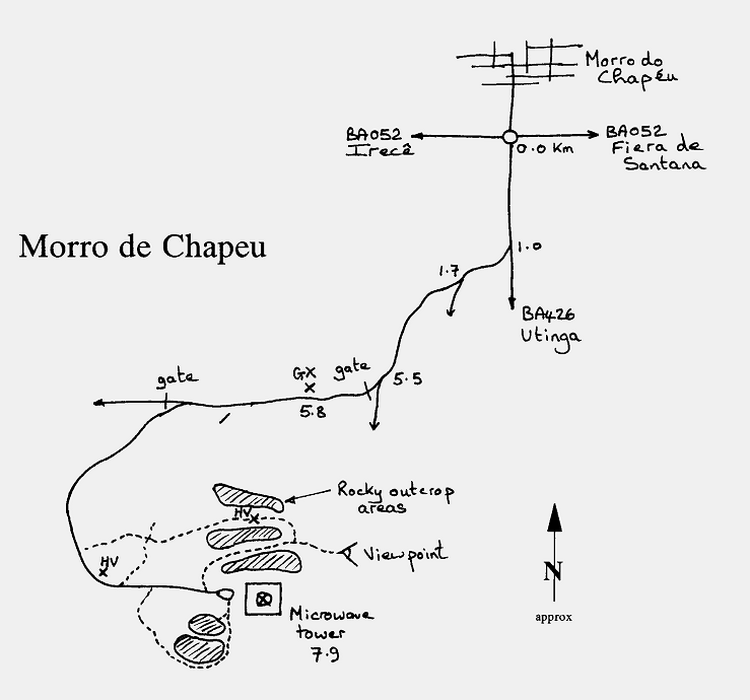
Working down from the top of the hill the habitat becomes denser caatinga, which is easily explored by investigating likely-looking areas from the main track. We worked an area 2.4 km from the top, finding Great Xenops, Pileated Antwren, and Grey-eyed Greenlet. This was apparently the first sighting of Great Xenops in the area for some time, though it would appear unlikely that the bird is rare here. Other possibilities supposedly include White-browed Guan, though the habitat, lacking any sizeable trees did not look ideal.
Another excellent birding area is the Rio Ferro Doido waterfall, east of Morro do Chapéu. In the event that the visorbearer cannot be found around the hill at Morro de Chapéu, this is a further locality in which to search. Leave Morro de Chapéu eastward for 18 kilometres on the BA052 toward Feira de Santana and stop at the bridge across a wide, rocky river-bed. Although not visible from the bridge, the spectacular waterfall (given sufficient water) falls into a deep canyon 200 metres from the road, on the north side. The habitat is open stony outcrops with patches of arid scrub, lower woodland and cacti. In addition to the possibility of Hooded Visorbearer, other species include Cinnamon Tanager, and White-vented Violetear. The short walk to peer over the edge of the waterfall is highly recommended, though not for those with an aversion to heights! At the time of our visit no water was flowing, and the river course was only comprised of large isolated pools. As the majority of the area in and around Morro de Chapéu is accessible caatinga further exploration would undoubtedly produce interesting records.
Species recorded from Morro de Chapéu:
Yellow-legged Tinamou |
Silvery-cheeked Antshrike 1h |
Senhor de Bonfim
As Senhor de Bonfim lies along the BR407 - the principle access route to Curaçá in extreme northern Bahia - good caatinga habitat to the north of town is likely to attract attention as one drives past. We stopped in three locations; the first, very degraded scrub and agricultural land on the southern outskirts of the town; the second, some rather degraded caatinga around a large microwave relay tower 22 kilometres north of town along the BR407; the third, some good caatinga 41 kilometres north of town also along the BR407. In retrospect, as good caatinga cannot be found any closer to town, it is worth driving at least 40 kilometres north of town along the BR407. Once this far out, quite large areas are still readily accessible from the road. At a point 41 kilometres north of town - watch kilometre markers - a wide gravel track on the right, east, passes along the edge of good habitat (see map). As the area is grazed by cows, several paths can be found into the area. The best access is offered by a wide track, running northward about 300 metres in from the road, leading to a large cleared area, along which we saw Silvery-cheeked Antshrike. Continuing along the western edge of this cleared area should enable you to follow a well-marked trail, through denser habitat, eventually returning to the road. A second access to the area can be found along the fence, starting at a point around one kilometre from the road. One hundred metres along this fence we found a pair of Lesser Wagtail-Tyrant. After about 1.5 kilometres from the road the track crosses a railway line and the habitat becomes less interesting. White Monjita was perched out on stumps in the cleared area to the south of the track. Several hotels can be found in Senhor de Bonfim. We stayed at the Hotel Planalto, on the BR-407, about one kilometre northeast of town.
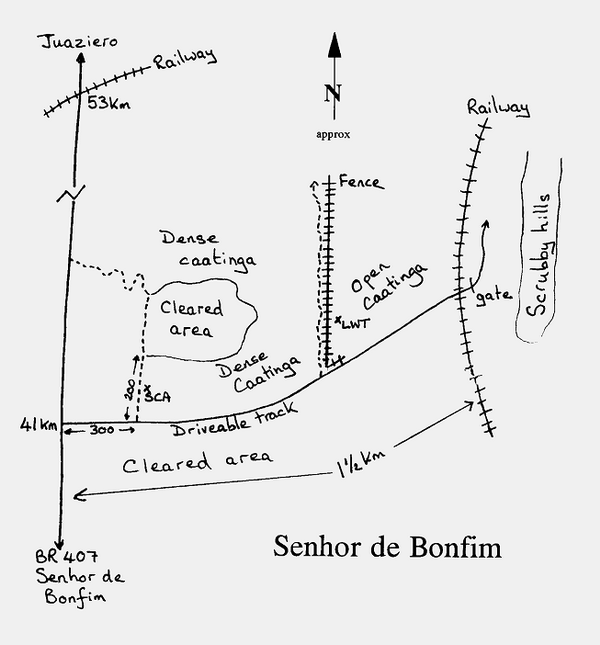
Species recorded from Senhor de Bonfim:
Yellow-legged Tinamou 3 |
Green-barred Woodpecker |
Section 1 - Introduction, logistics, itinerary and general information.
Section 3 - Birding sites (part 2).
Section 4 - Birding sites (part 3).
Section 5 - Annotated checklist.

